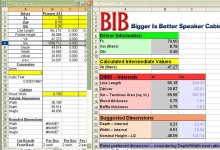GM and zilla site should be commended for such a valuable information for the diy folks here: http://www.zillaspeak.com/bib-howtobuild.asp
I downloaded the calculator both new and old, and I come up with a markedly different SM values as illustrated. I assume the old version is giving the right information.
I am unsure of the value units etc. (can't seem to send private email to GM).
I tried to insert the values for Pioneer 4.5 speaker here: http://www.partsexpress.com/pe/showdetl.cfm?&Partnumber=290-010
any help will be appreciate.
gychang
I downloaded the calculator both new and old, and I come up with a markedly different SM values as illustrated. I assume the old version is giving the right information.
I am unsure of the value units etc. (can't seem to send private email to GM).
I tried to insert the values for Pioneer 4.5 speaker here: http://www.partsexpress.com/pe/showdetl.cfm?&Partnumber=290-010
any help will be appreciate.
gychang
Attachments
gurley123 said:gychang,
That threw me for a loop at first to. The new calculator uses cubic feet instead of liters. There's a conversion table there on the new spreadsheet to convert the two.
will try it. gychang
gychang said:(can't seem to send private email to GM).
I wonder why, I have private messaging checked.........
GM
zayne742 said:gychang,
The liters vs. cuft is exactly why. I have updated the sheet again and passed it on for the Zilla site. This sheet has most of the popular drivers already built into it.
thanks, will check the site. gychang
The updated spreadsheet looks great. I will upload it to the site later today. Sorry to make you wait but it looks like it will be worth it. I need a few hours before updating the site... i have been trying to get back to work and playing catchup is not fun.
Peace,
Godzilla
Peace,
Godzilla
Here is the latest BIB Calculator!
http://www.zillaaudio.com/diy-speaker-building.htm
It's the second item down on the left. I am in the process of rebuilding my website so please forgive me for the broken links and work in progress.
If anyone has any questions do not hesitate to ask.
Godzilla
http://www.zillaaudio.com/diy-speaker-building.htm
It's the second item down on the left. I am in the process of rebuilding my website so please forgive me for the broken links and work in progress.
If anyone has any questions do not hesitate to ask.
Godzilla
Thenumbers for the 168e Sigma are already plugged in. I did lock the cells so that they did not accidently get changed. You can still change the wood thickness though. If you have different TS parameters, just put them into one of the blank colums. Let me know if this does not work.
Calculator
Don't quite know why but I can now see all the data, when I tried before this was all missing.
Thanks for all the hard work putting together a resoursce like this fantastic achievement .
Just need to total the wood requirements, order the drivers and have some fun

Don't quite know why but I can now see all the data, when I tried before this was all missing.
Thanks for all the hard work putting together a resoursce like this fantastic achievement .
Just need to total the wood requirements, order the drivers and have some fun

TS: factory or measured?
I would like to build BIBs for my 126E drivers. The measured TS specs are much closer to those measured by P10, than to the factory specs. I ran the measured specs in the new BIB calculator. Of course the enclosure dimensions are quite different from those calculated from the factory specs. In particular, the line length is 18 inches less, Vb is 20% greater, and Sm is over 30% higher.
Is the BIB design relatively insensitive to TS variations like the BVRs?
I would guess that a change in line length corresponds to a change in tuning frequency for the TL action in the bottom octave. Hence the shorter line calculated from the measured specs would not load the driver to as low a frequency as the 'factory spec' design.
Both of the designs (measured or factory) would 'vent' about mid-wall/corner. Would an inverted design, using floor/corner loading provide better loading?
In a given BIB design (like the 126e /factory specs), what does a change in Vb do with respect to response and effective driver loading? And Sm?
Thanks,
Bob
I would like to build BIBs for my 126E drivers. The measured TS specs are much closer to those measured by P10, than to the factory specs. I ran the measured specs in the new BIB calculator. Of course the enclosure dimensions are quite different from those calculated from the factory specs. In particular, the line length is 18 inches less, Vb is 20% greater, and Sm is over 30% higher.
Is the BIB design relatively insensitive to TS variations like the BVRs?
I would guess that a change in line length corresponds to a change in tuning frequency for the TL action in the bottom octave. Hence the shorter line calculated from the measured specs would not load the driver to as low a frequency as the 'factory spec' design.
Both of the designs (measured or factory) would 'vent' about mid-wall/corner. Would an inverted design, using floor/corner loading provide better loading?
In a given BIB design (like the 126e /factory specs), what does a change in Vb do with respect to response and effective driver loading? And Sm?
Thanks,
Bob
- Status
- This old topic is closed. If you want to reopen this topic, contact a moderator using the "Report Post" button.
- Home
- Loudspeakers
- Full Range
- BIB calculator problem...
